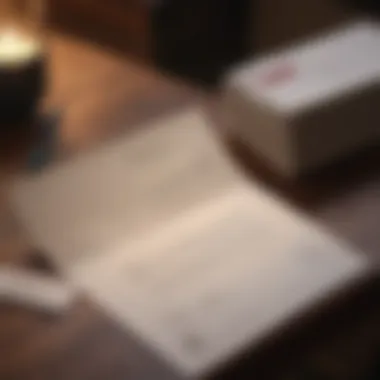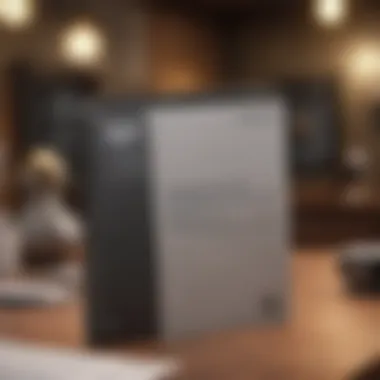Mastering Your Interview Covering Letter for Success


Intro
Importance of a Well-Structured Covering Letter
An interview covering letter is more than just a formality; it represents a unique opportunity to communicate directly with hiring managers. Unlike a resume, which is often a mere list of experiences and skills, a covering letter tells a story. It highlights motivations, passion, and how previous experiences prepare the applicant for the role. The significance of this letter cannot be overstated as it individually tailors the application.
\“A covering letter should speak to the employer, addressing their specific needs while outlining the candidate's fit for the role.\”
Key Components of A Covering Letter
An effective covering letter should contain several critical components. First, it must include an appropriate salutation, such as “Dear [Hiring Manager’s Name].” Next is an introductory paragraph summarizing the purpose of the letter, leading with a direct statement about the job being applied for. Following that is the body, which elaborates on relevant skills and experiences, and lastly, a conclusion inviting further discussion or interviews on the candidate's qualifications.
Best Practices for Drafting
Writing a compelling covering letter requires attention and effort. Here are some best practices to keep in mind:
- Tailor Each Letter: Personalize your letter for each job application.
- Highlight Key Achievements: Focus on specific accomplishments in previous roles that showcase your capabilities.
- Keep It Concise: Aim for a length that is easy to read while still providing necessary details.
By following these strategies, applicants can create letters that resonate well with hiring teams.
Common Pitfalls to Avoid
Errors in an interview covering letter can be detrimental. Here are some common mistakes:
- Generic Statements: Using clichés can make a letter forgettable. Be precise and specific to your skills and experiences.
- Typos and Grammatical Errors: Poor proofreading reflects a lack of professionalism. Always review your letter before sending.
- Lack of Research: Failing to research the company or role can leave the impression that you aren't fully invested in the opportunity.
By steering clear of these pitfalls, candidates can significantly enhance the impact of their covering letters and improve their chances of being noticed in the hiring process.
In synthesis, a strong covering letter is an essential tool in an applicant's arsenal. It enables job seekers to present themselves effectively, demonstrate their relevance to the position, and showcase their eagerness to contribute to the organization.
Preface to Interview Covering Letters
The introduction to interview covering letters sets the foundation for understanding their role in the job application process. In this competitive job landscape, candidates need a strategic approach to stand out. A well-crafted covering letter complements the resume by offering additional insights that highlight disparate features about a candidate's fit for a role.
Defining the Interview Covering Letter
An interview covering letter, often known as a cover letter, serves as a formal introduction to potential employers. This document is usually submitted along with a resume. While the resume provides a detailed account of qualifications and work experiences, the covering letter allows candidates to express their motivations and personality. In essence, it provides a narrative context to the candidate's professional journey. Writing a compelling covering letter can be akin to engaging in a direct conversation with the recruiter, conveying essential information clearly and effectively. In many instances, it acts as the first impression an employer has of a candidate, making it vital to define oneself accurately.
Importance in the Job Application Process
The significance of an interview covering letter cannot be understated. Here are several aspects emphasizing its importance:
- Personalization: A unique covering letter tailored to a specific job encompasses an applicant's enthusiasm for both the position and the company.
- Demonstrating Fit: Covering letters provide valuable opportunities for candidates to articulate why they are uniquely suitable for the role, thereby making a compelling case for interview consideration.
- Reflection of Professionalism: Submitting a thoughtfully written covering letter signals to recruiters a candidate's diligence. It can demonstrate a commitment to professionalism and attention to detail.
- Opportunity for Expansion: It grants candidates room to discuss skills and experiences that may not be fully represented in a resume or elucidate specific accomplishments narratively.
To navigate the competitive narrative of job applications successfully, your covering letter needs to encapsulate why you are the best fit for the desired role, positioning you as a prime candidate to potential employers.


Components of an Interview Covering Letter
The components of an interview covering letter play a significant role in demonstrating your professionalism and fit for the position you are applying for. These components work in unison to convey a respectful and articulate message to potential employers. Understanding each part enables candidates to produce a cohesive and compelling narrative that serves as their introduction. Failure to recognize the importance of well-structured components can lead to misunderstandings regarding qualifications or even an outright rejection.
Header Information
The header is the first element of your covering letter. It includes your name, address, phone number, and email. These details should be clearly presented, as they establish your identity and give the employer several ways to contact you. Ideally, this should be at the top of the letter, followed by the date and the recipient's details. Having a structured header not only ensures clarity but also manifests professionalism from the onset of your letter.
Salutation Techniques
Using an appropriate salutation impacts the tone of your letter. Ideally, a targeted salutation like: “Dear [Hiring Manager’s Name],” is ideal. This shows research effort and respect. If the name is inaccessible, a formal *
Best Practices for Writing
Writing an effective interview covering letter requires more than just filling in the blanks. Adhering to best practices can greatly enhance the impact of your letter. These practices guide your writing toward a precise goal: making a strong impression on a potential employer. By applying these principles, you can bolster your chances of securing an interview, showcasing your suitability for the role eloquently.
Tailoring Your Letter to the Job Description
Tailoring your letter to the specific job description is crucial. Each position has its unique requirements and expectations. To capture the attention of the employer, reflect key terms and phrases from the job posting in your letter. This demonstrates that you understand the role and can connect your experiences to what they need.
When addressing qualifications, consider the specified skills and experiences in the job description. For instance, if the posting emphasizes teamwork and project management, showcase your effective collaboration and leadership in previous roles. This not only conveys relevance but also increases the likelihood of invoking interest from the hiring manager.
Utilize a few of the following strategies aimed at strengthening your narrative:
- Review the job description thoroughly.
- Highlight specific accomplishments that align with the job.
- Adjust your letter to mirror the company’s values if relevant.
- Ensure your individual goals align with the organization’s objectives.
By doing so, you demonstrate a tailored fit for the position and your commitment to contributing positively to the organization.
Maintaining Professional Tone
The tone of your letter plays an important role in how you come across to an employer. It should strike a balance between professionalism and personal sincerity. A professional tone indicates respect, while sincerity builds rapport.
Use clear and straightforward language while avoiding jargon or overly complex terminology. This ensures that your message is both accessible and impactful. By seeking a genuine connection in your tone, you enhance the likelihood of an engaging reading experience.
To maintain the appropriate tone:
- Use formal salutations (e.g., “Dear Mr. Smith” instead of “Hey Joe”).
- Avoid slang.
- Stay polite and courteous through the text.
- Make your passion for the position clear without excessive enthusiasm.
These measures highlight your seriousness and show that you value the opportunity.
Ensuring Clarity and Conciseness
One of the pillars of an effective letter is clarity. Employers often skim letters within a brief time frame, and a clear, concise message will stand out. The goal is to communicate your strengths without unnecessary verbosity.
To ensure clarity, employ simple sentence structures and prioritize essential information over every detail of past employment. Only include relevant experiences and adjust your paragraph length to create rhythm in the reading experience.


A few key points to remember here:
- Focus only on relevant skills and experiences.
- Use bullet points or lists where appropriate to break content into digestible sections.
- Avoid redundant phrases. Instead of saying
Common Mistakes to Avoid
When constructing an interview covering letter, certain missteps can significantly impact its effectiveness. Understanding these pitfalls can prove essential for anyone looking to create a compelling narrative. Avoiding these errors not only amplifies focus but also heightens confidence in your presentation.
Generic Template Usage
Many individuals resort to using generic templates when crafting their covering letters. Although templates provide a basic structure, they can often lead to a lack of personalization. Employers can easily identify such letters, often hurting your chance of impressing them. It is crucial to customize your cover letter for every position you apply for.
When tailoring your letter, consider the following:
- Analyze the job description carefully. Note keywords and required skills.
- Reflect on your own experiences and align them with these keywords.
- Use specific examples or achievements that demonstrate your qualifications related to the position.
This method imparts a sense of genuine enthusiasm about the position and allows employers to see your suitability clearly.
Overly Complex Language
While using sophisticated vocabulary might seem impressive, it can alienate your reader if not done appropriately. Linguistic complexity can muddle your message. Clarity is often compromised by attempting to sound 'intelligent.' Thus, adopting a straightforward and simple language can enhance understanding.
Focus on:
- Clear and direct messaging.
- Using active voice to convey ideas succinctly.
- Refraining from jargon unless it is specific to the industry and commonly understood.
This approach helps maintain engagement and ensures that your essential skills shine through, free from the distractions of confusing language.
Neglecting Proofreading
A letter with typographical errors or grammatical issues promptly loses credibility. Employers may perceive this as a signal of carelessness, a trait unsuited for any professional role. Thus, thorough proofreading should be an integral part of your writing process.
Consider these strategies:
- Read your letter out loud. This often helps in catching errors you might miss otherwise.
- Utilize grammar checking tools such as Grammarly for additional support.
- Have someone else review your letter.
These practices not only assist in making your document error-free but strengthen overall content quality. Maintaining a polished appearance enhances reporting and reflects diligence and professionalism.
Always regard your covering letter as a reflection of yourself. Every care taken increases your potential to stand out in a competitive job landscape.
Example of an Effective Interview Covering Letter
An effective interview covering letter serves as a powerful tool in establishing a candidate’s presence in the job market. It is more than just a formality; it’s an opportunity to make a first impression on potential employers. By clearly presenting qualifications and ideal fit for a job, it sets the tone for subsequent interview conversations. An engaging letter grabs attention, creating a context that distinguishes the applicant from a crowded pool of candidates.
Understanding the layout and function of specific elements within the cover letter improves its efficacy. This can directly influence decisions made by hiring managers. Following a well-established structure helps demonstrate professionalism and organization. The effective elements include a precise header, tailored opening, focused body paragraphs, and a resolute closing.


Breakdown of Key Elements in an Example
In analysing the components of an example covering letter, clarity becomes key. Each section must convey singular intent and address necessary points.
- Header Information: This includes names, addresses, and dating of the letter. It establishes the writer’s identity and intent right from the outset. Make sure simple formatting minimizes distraction.
- Salutation: Choosing the correct salutation denotes respect and attention to detail. Avoid generic greetings when possible and include the hiring manager’s name, if known. Stand out early by personalizing communication.
- Opening Paragraph: This sets the stage. Introduce who you are and which position you’re applying for. This should engage readers immediately and promote them to want to read more.
- Body Paragraphs: These fit into encapsulated points such as:
- Closing Paragraph: This succinctly summarizes enthusiasm for the role, thanking the hiring manager for their consideration and expressing anticipation about discussing your application in detail.
- Signature and Contact Information: Conclude with a professional signature along with clear contact details, maintaining open communication lines.
- Articulating Fit for the Position: Align skills with job specifications. The employer should see how you fit seamlessly into their environment.
- Showcasing Relevant Skills and Experiences: Reflect on key skills relevant to the required role. Provide concise examples to strengthen your claims.
- Highlighting Accomplishments: Quantify achievements when possible. Numbers often tell compelling success stories.
Using a template can lead to dissatisfaction or mismatches. However, a personalized cover letter crafted from these principles can greatly bolster your positions within competitive fields. The strategy merged with clarity about content is instrumental in any job hunt process.
Leveraging the Covering Letter for Interviews
A well-crafted covering letter can significantly impact the interview process. It is not merely an introductory document but a strategic tool that lays the foundation for a successful dialogue with potential employers. Understanding how to leverage this document effectively can maximize your performance in interviews.is important.
Using the Letter as a Conversation Starter
Your covering letter is more than just a formality. It serves as an icebreaker in conversations during the interview. When you submit this letter, think of it as a personal invitation for recruiters to engage deeper with your application. You can present almost an outline of topics that you'll later discuss in detail during your interview. For example:
- Mention particular projects that align with the job requirements.
- Include quotes from past supervisors or feedback that establish your credibility.
Each point you bring up can prompt questions from the interviewer, allowing you to elaborate on experiences that showcase your unique abilities. This not only demonstrates your qualifications but shows your thoughtfulness in preparing for the interview.
Aligning with Interview Objectives
Mastering the objectives of the interview is crucial for effective presentation. When writing your covering letter, aim to reflect the core competencies sought by the employer.
- Research: Before the interview, carefully review the job description and the company's mission. Understand the priorities and values that mean the most to them.
- Reflection: Relate your skills and experiences in a way that aligns with those specified objectives. Use the covering letter to convey what you bring to the table that matches their needs. Highlighting specific examples could bolster your case.
The more your covering letter speaks directly to the organization's demands, the easier it will be to resonate with interviewers and position yourself as an ideal candidate.
Crafting an effective above-mentioned covering letter makes you not just a name on a resume but an engaging narrative that employers wish to explore.
End and Final Thoughts
In wrapping up this article, it is essential to underscore the value of a well-crafted covering letter within the job application framework. A thoughtfully composed covering letter serves as more than just a preliminary document; it is an opportunity to present complex ideas and articulate specific motivations for pursuing a position. Demonstrating one's understanding of the target organization and effectively resonating with its values significantly elevates an applicant's profile.
Recapitulating the Importance of a Covering Letter
The role of a covering letter in the job application process cannot be understated. It synthesizes the various elements of the candidate's professional journey and contextualizes the curriculum vitae. It should address the hiring managers with clarity, illuminating key experiences that directly relate to the position one aspires to hold.
Research shows that employers often rely on covering letters as a strong indicator of a candidate's interest and professionalism. It provides insight into not just what accomplishments are, but how an applicant perceives their relevance to the potential employer. Any specific qualifications, attributes, or aspirations articulated in the covering letter should be dynamic and aligned with the overarching mission of the organization. This alignment is crucial to capture attention in application reviews.
Encouraging Diligence in Crafting Your Letter
Crafting a compelling covering letter initiates a journey—one that requires careful reflection and diligence. Candidates should approach this task with the intent to make a profound impression. Each letter should be treated as a unique document. Relying on generic templates limits the ability to showcase individual strengths.
Consider conducting comprehensive research on the organization first. This permits the integration of pertinent facts and insights that can differentiate a letter from others.
Moreover, operationalizing good writing principles is imperative. Keeping grammar polished and spelling accurate reflects on the candidate’s attention to detail. Moreover, checking back if the reflected skills are in line with what has been demonstrate in past work experience forms a coherent narrative that enhances credibility.
Overall, the process of drafting a covering letter should not be viewed as mere formalism, but as a strategic endeavor that fosters clear, impactful communication with prospective employers.

